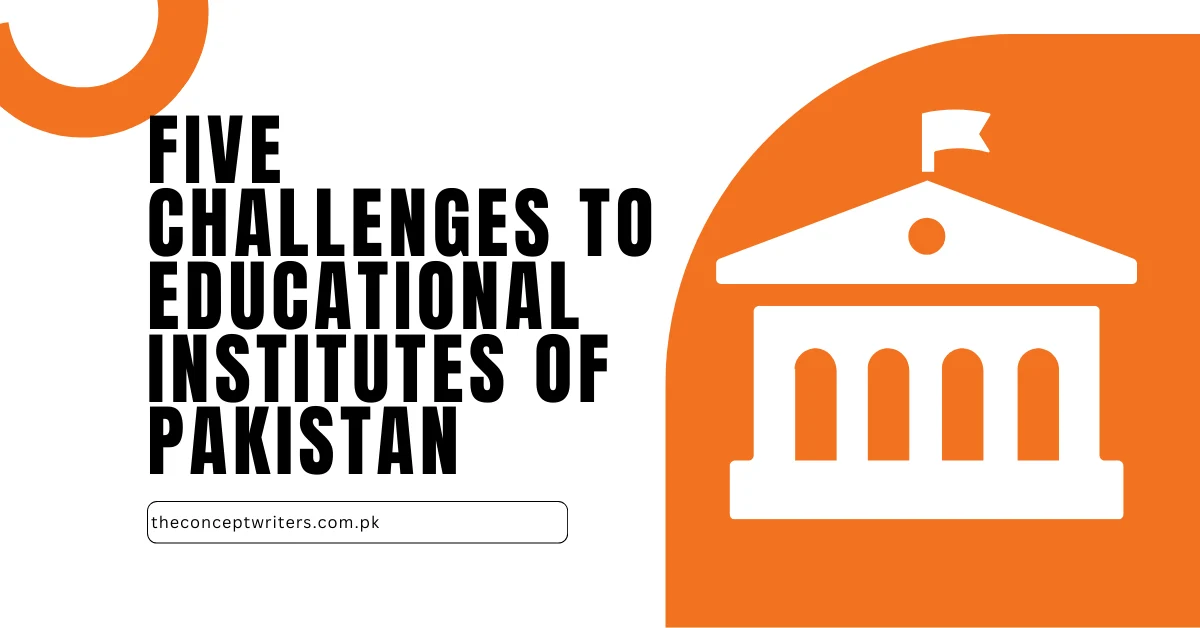Five Challenges to Educational Institutes of Pakistan
Pakistan is facing various challenges in the education sector that are hindering the development of its educational institutions. In this article, we will discuss the top five challenges faced by educational institutes in Pakistan and how they affect the education system.
Low literacy rate
The low literacy rate is a significant issue in the education sector of Pakistan, particularly in rural areas. According to the Pakistan Education Statistics 2019-20 report, the literacy rate in Pakistan is around 60%, which is significantly lower than the global average of 86%. This low literacy rate has many causes, such as poverty, lack of access to education, and cultural barriers, disproportionately affecting marginalized communities, particularly in rural areas.
One of the primary causes of low literacy rates in Pakistan is the lack of access to education. There is a significant shortage of schools in many rural areas, and those that do exist often need more basic facilities such as electricity, clean water, and sanitation. Additionally, there needs to be more qualified teachers in these schools, leading to poor quality of education.
Another significant cause of low literacy rates in Pakistan is poverty. Families living in poverty often cannot afford to send their children to school; instead, they must work to help support the family. This leads to a cycle of poverty and illiteracy, which is difficult to break without significant interventions.
The low literacy rate in Pakistan has many consequences, including limited economic growth, high unemployment rates, and social inequality. A lack of literacy and numeracy skills limits the potential for economic growth and competitiveness on a global scale.
Furthermore, with education, individuals can acquire the necessary skills and knowledge to engage in society fully, leading to social exclusion and inequality.
Need your Academic Tasks ASAP?
Need assistance with your Academic Tasks? Help is on the way!
Gender disparity
Gender disparity is a significant issue in the education sector of Pakistan. Despite significant progress over the past few decades, there are still significant gaps between the educational opportunities available to boys and girls, particularly in rural areas. This disparity has severe consequences for individuals, families, and the broader society, and addressing it requires significant investment and policy change.
One of the primary causes of gender disparity in education in Pakistan is the conservative social norms that prioritize boys’ education over girls. In many communities, girls are expected to stay home and perform household duties rather than attend school. Early marriage and strict gender roles further limit the ability of girls to access education and develop their skills.
The lack of access to education for girls has significant consequences for their future opportunities. Girls who are denied an education are at a higher risk of poverty, poor health, and limited social mobility. This, in turn, has severe consequences for their families and the broader society, as women are critical to community development and progress.
To address this issue, there is a need for significant investment in education, particularly in rural areas where the gender disparity is most pronounced. This investment should focus on building new schools, providing basic facilities such as electricity, clean water, and sanitation, and hiring qualified teachers, particularly women. Additionally, communities need to raise awareness about the importance of girls’ education and the negative consequences of denying them an education.
Insufficient funding
There needs to be more funding for educational institutes in Pakistan, particularly in rural areas. With adequate financial resources, educational institutions can provide the necessary infrastructure and resources to deliver quality education to students. This issue severely affects the quality of education in Pakistan and its long-term economic and social development.
The need for more funding for education in Pakistan is due to various factors, including political instability, economic downturns, and competing budget priorities. Despite government efforts to increase funding for education, it remains one of the least funded sectors in Pakistan. According to the Pakistan Education Statistics 2019-20 report, only 2.4% of GDP is allocated to education, which is well below the recommended level of 4-6% set by international bodies.
Quality of education
The quality of education in Pakistan has been a matter of concern for many years. Despite progress in some areas, the quality of education in many educational institutes still needs to improve. This has significant consequences for students, families, and the broader society, as education is critical to social and economic development.
There are several factors contributing to the low quality of education in Pakistan. These include a lack of investment in education, inadequate infrastructure, poorly trained teachers, and outdated teaching methods. Additionally, the educational system’s emphasis on rote learning and memorization has led to students needing more critical thinking skills.
Another significant issue facing the quality of education in Pakistan is the need for more standardization and accreditation processes. The absence of a national curriculum and evaluation system means that educational institutes have significant variations in the quality of education they offer. This has led to a lack of accountability and transparency in the education sector and a need to recognize high-performing institutions.
Limited access to higher education
Access to higher education is a significant challenge facing educational institutes in Pakistan. Despite progress in recent years, a significant portion of the population still needs access to higher education. This has significant consequences for the country’s long-term economic and social development.
One significant factor contributing to limited access to higher education in Pakistan is the limited number of institutions. According to the Higher Education Commission of Pakistan, 197 universities and degree-awarding institutions are currently in the country. While this number has increased over the years, it is still relatively low compared to the country’s population size. Furthermore, many of these institutions are concentrated in urban areas, making it difficult for students in rural areas to access higher education.
Another significant factor contributing to limited access to higher education in Pakistan is the high cost of education. Many students need help to afford the high cost of tuition fees, transportation, and accommodation. This is particularly true for students from low-income families, who are often unable to access higher education due to financial constraints.
Conclusion
In conclusion, the education system in Pakistan is facing several challenges hindering its growth and development. These challenges include low literacy rates, gender disparity, insufficient funding, quality of education, and limited access to higher education. To overcome these challenges, there is a need for the government, individuals, and organizations to work together to improve the education system in Pakistan.
This can be achieved through increased funding for education, improving access to education, promoting gender equality, enhancing the quality of education, and encouraging research and development. By addressing these challenges, Pakistan can create a more educated and skilled workforce, which can contribute to the development of the country and its economy.
Need your Academic Tasks ASAP?
Need assistance with your Academic Tasks? Help is on the way!





